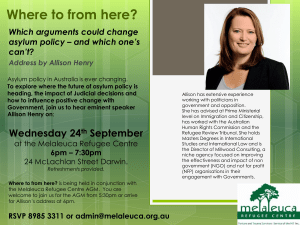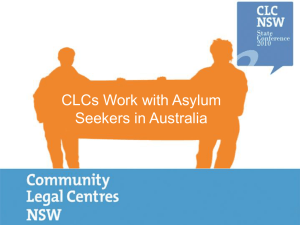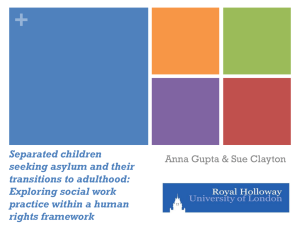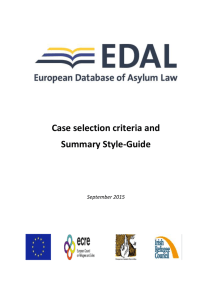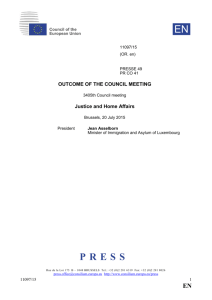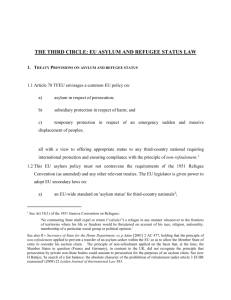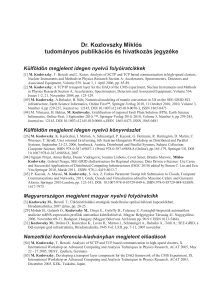to Ms. Cecilia Malmström Commissioner for Home Affairs European
advertisement
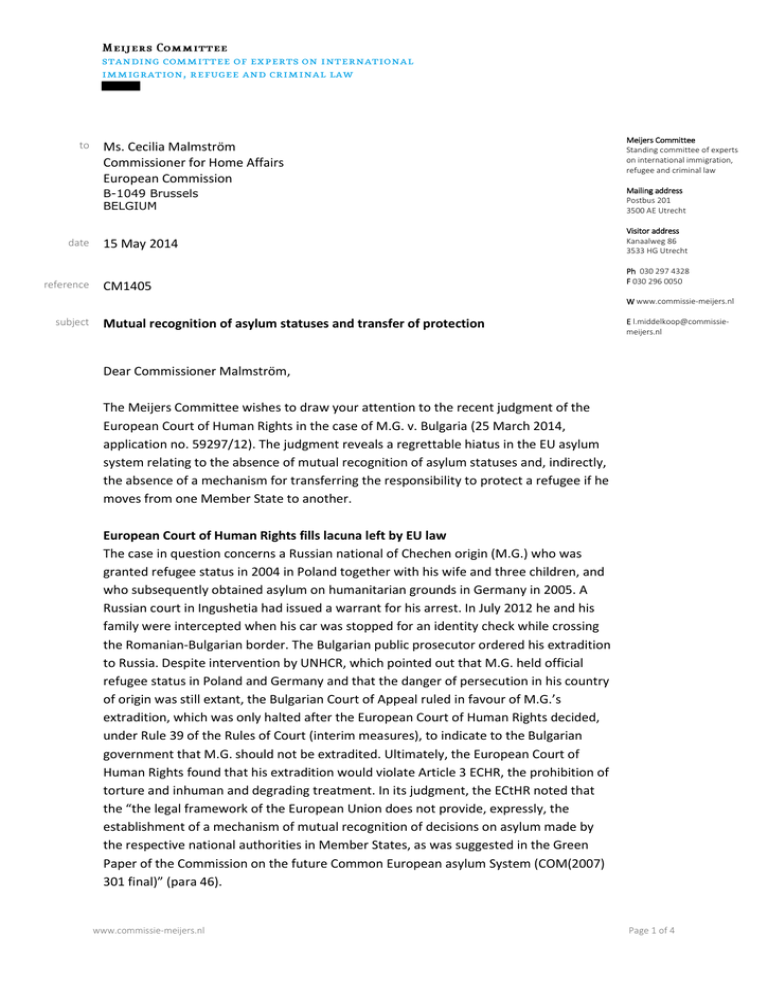
to date reference Ms. Cecilia Malmström Commissioner for Home Affairs European Commission Meijers Committee Standing committee of experts on international immigration, refugee and criminal law B-1049 Brussels BELGIUM Mailing address Postbus 201 3500 AE Utrecht 15 May 2014 Visitor address Kanaalweg 86 3533 HG Utrecht CM1405 Ph 030 297 4328 F 030 296 0050 W www.commissie-meijers.nl subject Mutual recognition of asylum statuses and transfer of protection E l.middelkoop@commissiemeijers.nl Dear Commissioner Malmström, The Meijers Committee wishes to draw your attention to the recent judgment of the European Court of Human Rights in the case of M.G. v. Bulgaria (25 March 2014, application no. 59297/12). The judgment reveals a regrettable hiatus in the EU asylum system relating to the absence of mutual recognition of asylum statuses and, indirectly, the absence of a mechanism for transferring the responsibility to protect a refugee if he moves from one Member State to another. European Court of Human Rights fills lacuna left by EU law The case in question concerns a Russian national of Chechen origin (M.G.) who was granted refugee status in 2004 in Poland together with his wife and three children, and who subsequently obtained asylum on humanitarian grounds in Germany in 2005. A Russian court in Ingushetia had issued a warrant for his arrest. In July 2012 he and his family were intercepted when his car was stopped for an identity check while crossing the Romanian-Bulgarian border. The Bulgarian public prosecutor ordered his extradition to Russia. Despite intervention by UNHCR, which pointed out that M.G. held official refugee status in Poland and Germany and that the danger of persecution in his country of origin was still extant, the Bulgarian Court of Appeal ruled in favour of M.G.’s extradition, which was only halted after the European Court of Human Rights decided, under Rule 39 of the Rules of Court (interim measures), to indicate to the Bulgarian government that M.G. should not be extradited. Ultimately, the European Court of Human Rights found that his extradition would violate Article 3 ECHR, the prohibition of torture and inhuman and degrading treatment. In its judgment, the ECtHR noted that the “the legal framework of the European Union does not provide, expressly, the establishment of a mechanism of mutual recognition of decisions on asylum made by the respective national authorities in Member States, as was suggested in the Green Paper of the Commission on the future Common European asylum System (COM(2007) 301 final)” (para 46). www.commissie-meijers.nl Page 1 of 4 No uniform EU asylum status The Meijers Committee considers it an aberration that the current state of EU asylum law permits a practice whereby a Member State is free to extradite or expel to a third country a third-country national who has obtained refugee status in another member State. This contrasts with the aim, which is repeated time and again in EU policy documents, that EU asylum law is based on a “common area of protection and solidarity based on a common asylum procedure and a uniform status valid throughout the Union.” Article 78(2)(a) TFEU obliges the Union legislator to adopt measures ensuring a “uniform status of asylum for nationals of third countries, valid throughout the Union.” In reality, the legal provisions of the EU asylum directives stop short of creating a ‘common protection area’ or ‘a status that is valid throughout the Union’. Recognised refugees enjoy no right to take up residence in another Member State until the refugee has obtained the status of long-term resident. More pressingly, there is no explicit obligation on Member States to recognise the protection status granted by another Member State. A refugee can obtain the status of long-term resident only after a period of legal residence of five years. If a long-term resident refugee takes up residence in a second Member State, the long-term resident directive states that the refugee may be expelled only to the Member State which granted international protection, and that that Member State is obliged to readmit the person (Article 12 (3) (b) of Directive 2011/51/EU). An exception is provided for persons who constitute a danger to the community of the second Member State, but in all cases the prohibition of refoulement must be respected. Furthermore, Article 6(2) of the Returns Directive (2008/115/EC) provides that third-country nationals staying illegally on the territory of a Member State and holding a valid residence permit issued by another Member State must be expelled to that other Member State. That rule, however, does not apply in situations similar to the case of M.G. v Bulgaria, where a third-country national makes use of his right to move freely for up to three months within the territories of other Member States. This is especially relevant in cases where extradition is sought by a third country. The Meijers Committee considers that the legal solutions of the long-term residence directive and the Returns directive represent a good first step, but they are only a first step. They do not apply to all beneficiaries of international protection who move within the EU, and they do not provide a genuine mechanism for transferring responsibility for protection. The 1980 European Agreement on Transfer of Responsibility for Refugees, concluded under the auspices of the Council of Europe, contains a more comprehensive framework for the transfer of responsibility for protection, the basic rule being that responsibility is transferred after a period of two years of the refugee’s actual stay in the second State. This convention leaves a number of issues unsettled, however, and it has been ratified by only eleven Member States. www.commissie-meijers.nl Page 2 of 4 Recommendations In the Meijers Committee’s view, comprehensive consideration should be given at the EU level to the allocation of responsibilities between Member States in any situation where an international protection beneficiary moves to another Member State, either temporarily or permanently. Without it, the common EU asylum system is incomplete and inconsistent. Although the Meijers Committee is of the view that the EU should focus on consolidation and evaluation of its justice and home affairs policies in the coming years, inaction on the issue of mutual recognition of protection statuses will undermine the efficacy of the Common European Asylum System. Any such framework should address two issues. First, the principle of mutual recognition of all statuses granted on the basis of the Qualification directive (2011/95/EU) should be laid down in EU law. This principle should at least entail the basic rule that a beneficiary of international protection may be expelled only to the Member State which granted international protection, and that that Member State is obliged to readmit the person. This would expand the rule currently applicable to international beneficiaries who are long-term residents and who reside in another Member State, to the all categories of international protection beneficiaries, regardless of the type of stay in another Member State. Such a rule should also preclude the extradition of a third country national who has been granted asylum by another Member State. Secondly, an EU mechanism for the transfer of responsibility should ensure that persons granted international protection on the basis of the Qualification directive and who lawfully take up residence in another Member State are duly granted the rights and benefits laid down in the Qualification directive in the second Member State, after some period of legal residence. In line with the European Agreement on Transfer of Responsibility, the basic rule could be that responsibility is transferred after a period of two years of the international protection beneficiary’s actual stay in the second Member State. This would mean that the second Member State becomes responsible for granting the rights and benefits laid down in the Qualification directive. As such, the European Agreement would potentially become redundant for EU Member States. If the transfer of responsibility had not been carried out, and the protected person no longer fulfilled the criteria for mobility, he would still be the responsibility of the Member State which had granted international protection, and should in theory at least be returned to that State; and if expulsion from the second Member State becomes an issue, he should be returned to the first (and still) protecting Member State to ensure non-refoulement. Revising the Qualification directive The Meijers Committee considers the Qualification directive best suited to incorporate rules on mutual recognition of asylum statuses and transfer of protection. That directive already presumes, but only implicitly, that a protection status granted by a Member State should be effective in the EU as a whole. For instance, recital 9 alludes to a ‘uniform status’ and recital 12 speaks of ensuring a ‘minimum level of benefits in all www.commissie-meijers.nl Page 3 of 4 Member States’. Article 1 sets out that the purpose of the directive is inter alia to lay down standards for a ‘uniform status’. Pending such legislative action, the Meijers Committee invites the Commission to publish guidelines and/or the Council to issue a recommendation on the application of the ECHR and the Charter in cases similar to M.G. v Bulgaria. The Meijers Committee welcomes the opportunity to discuss this issue you in greater detail and explore viable options.We are available to answer further questions. Sincerely, Prof. Kees Groenendijk Chairman Cc: The President of the Council of the European Union; The chairman of the LIBE Committee of the European Parliament www.commissie-meijers.nl Page 4 of 4

